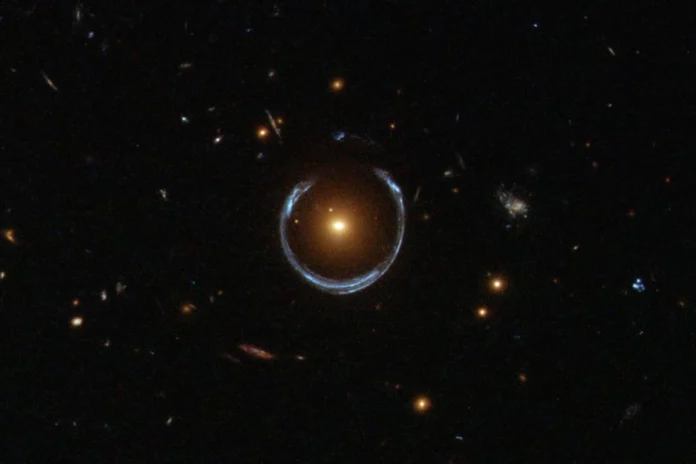The largest black hole ever discovered has a mass 36 billion times greater than that of our Sun. It exists near the upper limit predicted by our cosmological models, leaving astronomers with pressing questions about the relationship between black holes and the galaxies in which they reside.
In an article published on August 7 in the journal Monthly Notices of the Royal Astronomical Society, researchers announced the discovery of a black hole inside a supermassive galaxy located 5 billion light-years from Earth, which they named “Cosmic Horseshoe.” According to the statement, the newly discovered monster is approximately 10,000 times heavier than the supermassive black hole at the center of the Milky Way. Theoretical predictions set the upper limit of a black hole’s mass at 40-50 billion times the mass of the Sun; this cosmic giant has a mass 36 billion times greater than the Sun, so it is dangerously close to what calculations allow.
The enormous size of the Cosmic Horseshoe noticeably distorts space-time, bending light from neighboring galaxies into a horseshoe-shaped glow called an Einstein ring. This accidental celestial feature, along with more traditional detection methods, allowed astronomers to spot a new black hole that has not yet been named.
“This is one of the 10 most massive black holes ever discovered, and quite possibly the most massive,” said Thomas Collett, co-author of the study and cosmologist at the University of Portsmouth in England, in a statement. “Most other measurements of black hole masses are indirect and have a fairly large margin of error, so we don’t really know for sure which one is the largest.”
Most large galaxies, including the Milky Way, have supermassive black holes at their centers. Cosmological models predicted that larger galaxies, such as the Cosmic Horseshoe, could contain even larger, “ultramassive” black holes. However, such ultra-massive black holes were difficult to detect because the traditional method of tracking the motion of stars around them — stellar kinematics — was ineffective for inactive, distant black holes.
Researchers overcame this limitation using gravitational lensing, a method that does not rely on the need to “see” the movement of cosmic objects. They also used observational data from the Large Telescope and the Hubble Space Telescope to create a comprehensive model of the galaxy. This two-pronged approach allowed the team to detect the “sleeping” black hole “solely by its enormous gravitational force and the influence it exerts on its surroundings,” explained Carlos Melo, lead author of the study and a doctoral student at the Federal University of Rio Grande do Sul in Brazil, in the same statement.
“We detected the black hole’s influence in two ways,” said Collett. “It changes the trajectory of light passing by the black hole and causes stars in the inner regions of the galaxy in which it is located to move extremely fast. By combining these two measurements, we can be completely sure that the black hole actually exists.”
“What’s particularly interesting is that this method allows us to detect and measure the mass of these hidden supermassive black holes throughout the universe,” Melos added, “even when they are completely silent.”
Another notable feature of the Cosmic Horseshoe environment is that it is a “cluster of fossils.” These dark, massive systems are mainly driven by gravitational forces and are usually the end product of a series of galaxy mergers.
“It is likely that all the supermassive black holes that were originally in the companion galaxies have now also merged to form the supermassive black hole we have discovered,” said Collett. “So we are seeing the final state of galaxy formation and the final state of black hole formation.”
The new black hole is impressive, and it will be interesting to see what else astronomers discover about it. It is also a great example of multi-messenger astronomy — the coordination of different types of signals from the same astronomical phenomenon. This has been extremely important for rethinking phenomena that we thought we had already “explored,” but it also holds promise for supporting entirely new discoveries. In any case, there is no doubt that we are closer than ever to unraveling many of the mysteries of our universe.









